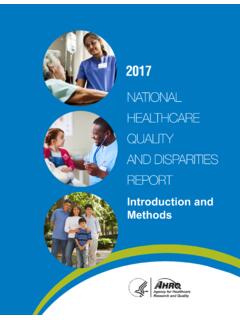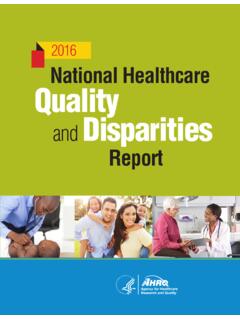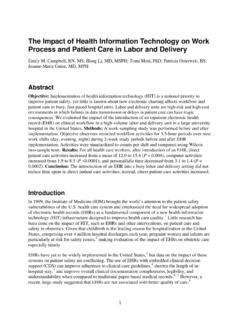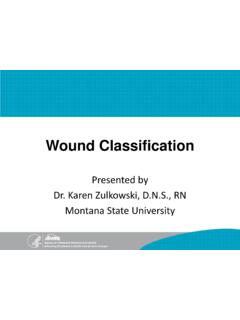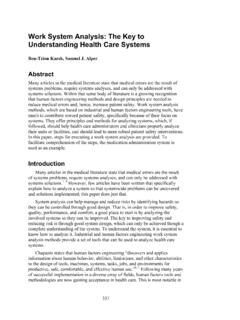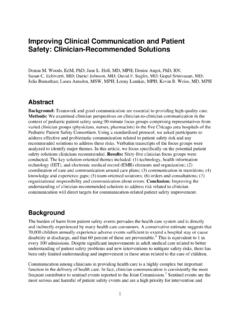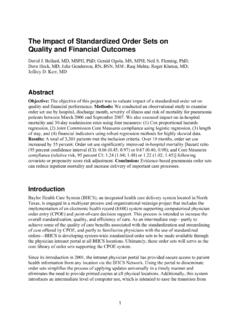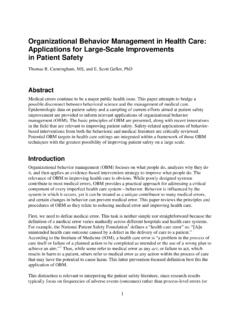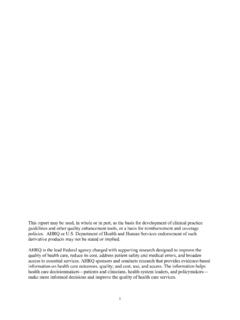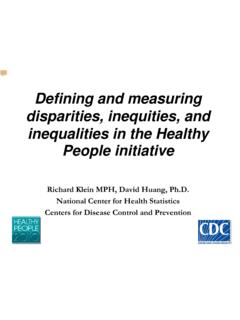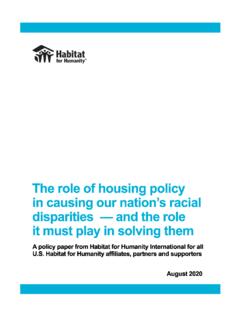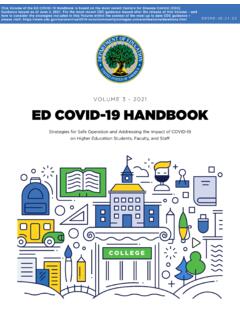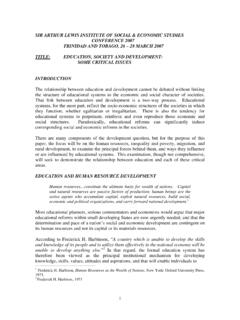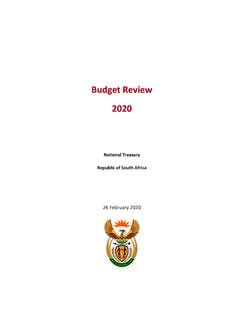Transcription of Disparities in Healthcare Quality Among Racial and Ethnic ...
1 Disparities in Health Care Quality Among Racial and Ethnic Minority Groups: Selected Findings From the 2010 National Healthcare Quality and Disparities Reports Introduction million Blacks or African Americans ( of the population); more than million Each year since 2003, the Agency for Healthcare Hispanics or Latinos ( ); almost million Research and Quality (AHRQ) has reported on Asians ( ); more than million Native progress and opportunities for improving health Hawaiians and Other Pacific Islanders (NHOPIs). care Quality and reducing health care Disparities . ( ); and more than million American As mandated by the Congress, the National Indians and Alaska Natives (AI/ANs) ( ), of Healthcare Quality Report (NHQR) focuses on whom 57% reside on Federal trust lands. Racial national trends in the Quality of health care and Ethnic minorities are more likely than non- provided to the American people while the Hispanic Whites to be poor or near poor.
2 In National Healthcare Disparities Report (NHDR) addition, Hispanics, Blacks, and some Asian focuses on prevailing Disparities in health care subgroups are less likely than non-Hispanic Whites delivery as it relates to Racial factors and to have a high school education . socioeconomic factors in priority populations. Disparities in Quality of care are common: Priority populations include Racial and Ethnic minorities, low-income groups, women, children, l Blacks and AI/ANs received worse care than older adults, residents of rural areas and inner Whites for about 40% of measures. cities, and individuals with disabilities and special l Asians received worse care than Whites for health care needs. about 20% of measures. Racial and Ethnic Minorities l Hispanics received worse care than non- Hispanic Whites for about 60% of core In 2000, about 33% of the population measures.
3 Identified themselves as members of Racial or Ethnic minority groups. By 2050, it is projected l Poor people received worse care than high- that these groups will account for almost half of income people for about 80% of core the population. For 2007, the Census measures. Bureau estimated that the United States had almost Agency for Healthcare Research and Quality Advancing Excellence in Health Care Priority Populations Disparities in access are also common, Few Disparities in Quality of care are getting especially Among Hispanics and poor people: better: l Blacks had worse access to care than Whites l Fewer than 20% of Disparities faced by for one-third of core measures. Blacks, AI/ANs, Hispanics, and poor people showed evidence of narrowing. l Asians and AI/ANs had worse access to care than Whites for one of five core measures.
4 L The Asian-White gap was narrowing for about 30% of core measures, the largest l Hispanics had worse access to care than non- proportion of any group, but most Disparities Hispanic Whites for five of six core measures. were not changing. l Poor people had worse access to care than high-income people for all six core measures. Largest Racial , Ethnic , and socioeconomic Disparities that are not improving*. Black compared with White Relative rate Hospital admissions for lower extremity amputations per 1,000 population age 18 and over with diabetes Emergency department visits where patients left without being seen Adults age 65 and over who ever received pneumococcal vaccination Asian compared with White Adults age 65 and over who ever received pneumococcal vaccination People with a usual primary care provider Adults who had a doctor's office or clinic visit in the last 12 months whose health providers listened carefully, explained things clearly, respected what they had to say.
5 And spent enough time with them American Indian or Alaska Native compared with White People under age 65 with health insurance Hospital patients with heart failure who received recommended hospital care Adults age 50 and over who ever received colorectal cancer screening Hispanic compared with Non-Hispanic White New AIDS cases per 100,000 population age 13 and over People under age 65 with health insurance People with a specific source of ongoing care Poor compared with High Income People under age 65 with health insurance Female Medicare beneficiaries age 65 and over who reported ever being screened for osteoporosis with a bone mass or bone density measurement People with a specific source of ongoing care * To compare relative rates (RRs), measures were framed negatively. An RR > 1 indicates that a group is receiving poorer Quality of care or facing larger problems with access to care compared with the reference group.
6 For example, an RR of indicates that Asians are times more likely than Whites not to have a usual primary care provider. 2. Barriers to Access and Quality Health Care l In 2008, the percentage of people with a specific source of ongoing care was lower for Access to care measures include facilitators and Blacks than for Whites ( compared with barriers to care and health care utilization ) and significantly lower for Hispanics experiences of subgroups defined by race and than for non-Hispanic Whites ( ethnicity, income, education , availability of health compared with ). insurance, limited English proficiency, and availability of a usual source of care. l In 2008, the percentage of people with a specific source of ongoing care was Health Insurance Status significantly lower for poor people than for high-income people ( compared with l Overall, there was no significant change from ).
7 1999 to 2008. In 2008, about of people under age 65 had health insurance. l The percentage of people with a specific source of ongoing care was lower for people l In 2008, Asians under age 65 were more likely with less than a high school education and for than Whites to have health insurance ( people with a high school education than for compared with ). AI/ANs under age 65 people with at least some college education were less likely than Whites to have health ( and , respectively, compared insurance ( compared with ). with ). There were no statistically significant differences for other Racial groups. Quality and Access to Care for Populations l In 2008, Hispanics under age 65 were less With Limited English Proficiency likely than non-Hispanic Whites to have health insurance ( compared with ). Limited English proficiency is a barrier to Quality health care for many Americans.
8 Of the 281 million l From 1999 to 2008, while the percentage of people age 5 and over in the United States in 2007, people with health insurance increased for million individuals (20%) reported speaking a poor people (from to ), the language other than English at home. Many of percentage worsened for middle-income these people lack health insurance. people (from to ). In 2008, the percentage of people with health insurance l Compared with patients who speak English at was significantly lower for poor, near-poor, home, patients who speak Spanish at home and middle-income people than for high- were more likely to report poor income people ( , , and communication with nurses while patients respectively, compared with ). who speak some other language at home were more likely to report poor communication l In 2008, the percentage of people with health with both nurses and doctors.
9 Insurance was about one-third lower for people with less than a high school education l In 2007, Hispanic adults were significantly than for people with at least some college more likely than non-Hispanic adults to have a education ( compared with ). usual source of care with language assistance. l In 2007, White adults with limited English Specific Source of Ongoing Care proficiency were significantly more likely l Overall, percent of people had a than Asians to have a usual source of care specific source of ongoing care in 2008. with language assistance. 3 3. l In 2007, non-Hispanic White patients in Disparities in preventive services and access California were significantly less likely than to care. Hispanic patients to need a translator during l Progress is uneven with respect to eight their last doctor visit.
10 Non-Hispanic Whites national priority areas: were also less likely than Mexicans and Central Americans to need a translator. Asians were Two are improving in Quality : (1) Palliative significantly more likely than non-Hispanic and End-of-Life Care and (2) Patient and Whites to need a translator during their last Family Engagement. doctor visit ( compared with ). There Three are lagging: (3) Population Health, were, however, no statistically significant (4) Safety, and (5) Access. differences between the overall Asian Three require more data to assess: (6) Care population and Chinese or Vietnamese patients. Coordination, (7) Overuse, and (8) Health There were also no significant differences System Infrastructure. between Chinese and Vietnamese patients. All eight priority areas showed Disparities l In California, patients under age 65 with public related to race, ethnicity, and insurance and uninsured patients were less socioeconomic status.
